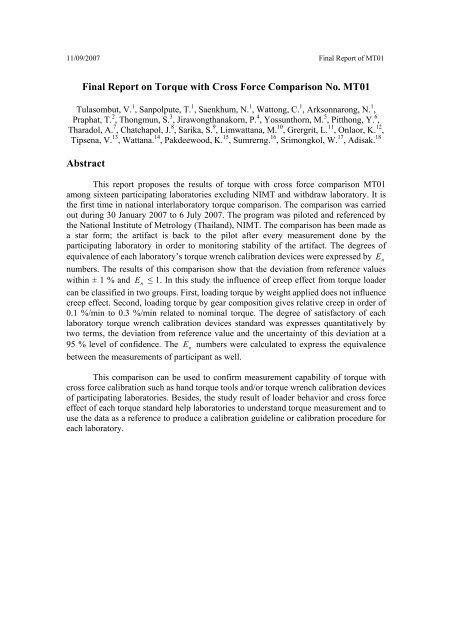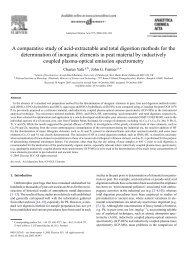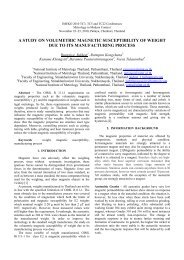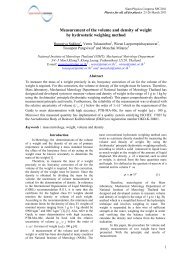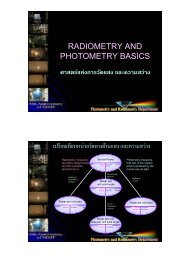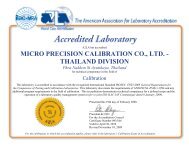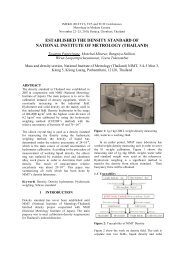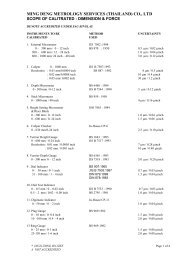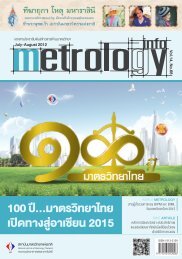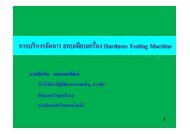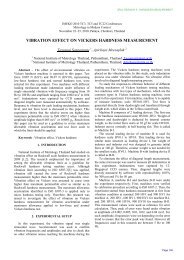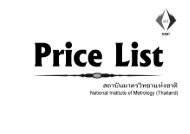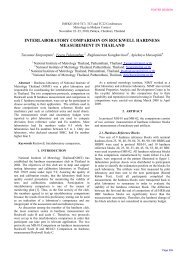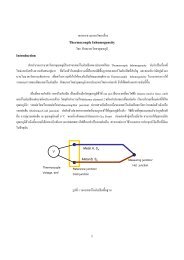Final Report on Torque with Cross Force Comparison No. MT01 ...
Final Report on Torque with Cross Force Comparison No. MT01 ...
Final Report on Torque with Cross Force Comparison No. MT01 ...
- No tags were found...
Create successful ePaper yourself
Turn your PDF publications into a flip-book with our unique Google optimized e-Paper software.
11/09/2007 <str<strong>on</strong>g>Final</str<strong>on</strong>g> <str<strong>on</strong>g>Report</str<strong>on</strong>g> of <strong>MT01</strong><str<strong>on</strong>g>Final</str<strong>on</strong>g> <str<strong>on</strong>g>Report</str<strong>on</strong>g> <strong>on</strong> <strong>Torque</strong> <strong>with</strong> <strong>Cross</strong> <strong>Force</strong> Comparis<strong>on</strong> <strong>No</strong>. <strong>MT01</strong>Tulasombut, V. 1 , Sanpolpute, T. 1 , Saenkhum, N. 1 , Watt<strong>on</strong>g, C. 1 , Arks<strong>on</strong>nar<strong>on</strong>g, N. 1 ,Praphat, T. 2 , Th<strong>on</strong>gmun, S. 3 , Jiraw<strong>on</strong>gthanakorn, P. 4 , Yossunthorn, M. 5 , Pitth<strong>on</strong>g, Y. 6 ,Tharadol, A. 7 , Chatchapol, J. 8 , Sarika, S. 9 , Limwattana, M. 10 , Grergrit, L. 11 , Onlaor, K. 12 ,Tipsena, V. 13 , Wattana. 14 , Pakdeewood, K. 15 , Sumrerng. 16 , Srim<strong>on</strong>gkol, W. 17 , Adisak. 18AbstractThis report proposes the results of torque <strong>with</strong> cross force comparis<strong>on</strong> <strong>MT01</strong>am<strong>on</strong>g sixteen participating laboratories excluding NIMT and <strong>with</strong>draw laboratory. It isthe first time in nati<strong>on</strong>al interlaboratory torque comparis<strong>on</strong>. The comparis<strong>on</strong> was carriedout during 30 January 2007 to 6 July 2007. The program was piloted and referenced bythe Nati<strong>on</strong>al Institute of Metrology (Thailand), NIMT. The comparis<strong>on</strong> has been made asa star form; the artifact is back to the pilot after every measurement d<strong>on</strong>e by theparticipating laboratory in order to m<strong>on</strong>itoring stability of the artifact. The degrees ofequivalence of each laboratory’s torque wrench calibrati<strong>on</strong> devices were expressed by Ennumbers. The results of this comparis<strong>on</strong> show that the deviati<strong>on</strong> from reference values<strong>with</strong>in ± 1 % and En≤ 1. In this study the influence of creep effect from torque loadercan be classified in two groups. First, loading torque by weight applied does not influencecreep effect. Sec<strong>on</strong>d, loading torque by gear compositi<strong>on</strong> gives relative creep in order of0.1 %/min to 0.3 %/min related to nominal torque. The degree of satisfactory of eachlaboratory torque wrench calibrati<strong>on</strong> devices standard was expresses quantitatively bytwo terms, the deviati<strong>on</strong> from reference value and the uncertainty of this deviati<strong>on</strong> at a95 % level of c<strong>on</strong>fidence. The Ennumbers were calculated to express the equivalencebetween the measurements of participant as well.This comparis<strong>on</strong> can be used to c<strong>on</strong>firm measurement capability of torque <strong>with</strong>cross force calibrati<strong>on</strong> such as hand torque tools and/or torque wrench calibrati<strong>on</strong> devicesof participating laboratories. Besides, the study result of loader behavior and cross forceeffect of each torque standard help laboratories to understand torque measurement and touse the data as a reference to produce a calibrati<strong>on</strong> guideline or calibrati<strong>on</strong> procedure foreach laboratory.
<str<strong>on</strong>g>Final</str<strong>on</strong>g> <str<strong>on</strong>g>Report</str<strong>on</strong>g> of <strong>MT01</strong>C<strong>on</strong>tents:Page1. Introducti<strong>on</strong> 32. Participating laboratories and their standards 42.1 List of participating laboratories2.2 Standards of participating laboratories3. Circulati<strong>on</strong> of the artifacts 63.1 Chr<strong>on</strong>ology of Measurements3.2 Transportati<strong>on</strong>4. Measurement 94.1 Measurement process4.2 Metrological investigati<strong>on</strong>5. Characteristics of the artifact 105.1 Creep effect5.2 Stability of the artifact6. Measurement data 117. Analyzing method of comparis<strong>on</strong> results 148. Comparis<strong>on</strong> results 149. Discussi<strong>on</strong> and c<strong>on</strong>clusi<strong>on</strong> 33Annex A: Metrological investigati<strong>on</strong> 34References 452
<str<strong>on</strong>g>Final</str<strong>on</strong>g> <str<strong>on</strong>g>Report</str<strong>on</strong>g> of <strong>MT01</strong>1. Introducti<strong>on</strong>The Nati<strong>on</strong>al Institute of Metrology (Thailand) or NIMT was requested to be anorganizer and a reference participant of interlaboratory comparis<strong>on</strong> in torque <strong>with</strong> crossforce measurement am<strong>on</strong>g laboratories in Thailand. An invitati<strong>on</strong> was distributed tolaboratories <strong>on</strong> December 2006 by the pilot laboratory, NIMT. Sixteen laboratoriesresp<strong>on</strong>ded to participate in this comparis<strong>on</strong>. A draft protocol of the comparis<strong>on</strong> wasprepared by pilot laboratory and distributed to participating laboratories <strong>on</strong> January 2007.The comments and opini<strong>on</strong>s are corrected. All participants accepted and approved theprotocol.The participating laboratories used torque wrench calibrati<strong>on</strong> devices as theirstandard. The artifact of this comparis<strong>on</strong> was provided by the instrument calibrati<strong>on</strong>laboratory Rajamangala University of Technology Thanyaburi, RMUTT by using a highquality torque transfer wrench subjected to similar loading profiles in laboratory’sstandard and following a strict measurement protocol. Regarding to time table, an artifactwas sent to participants by staff of RMUTT <strong>on</strong> time.The reference values were measured at the beginning, the middle and the end ofprogram. The measurement results of the participants were submitted to the pilotlaboratory to analyze the deviati<strong>on</strong> and degrees of equivalence in this report.3
<str<strong>on</strong>g>Final</str<strong>on</strong>g> <str<strong>on</strong>g>Report</str<strong>on</strong>g> of <strong>MT01</strong>2. Participating laboratories and their standards2.1 List of participating laboratoriesThe participating laboratories are listed in table 1 arranged by the order ofmeasurement.Table 1. List of participating laboratories of the torque <strong>with</strong> cross force comparis<strong>on</strong>Laboratories1. Nati<strong>on</strong>al Instituteof Metrology(Thailand), NIMT2. ElectricityGeneratingAuthority of Thailand(EGAT)3. ReferenceStandards LaboratoryThai AirwaysInternati<strong>on</strong>al PublicCompany Limited4. Quality Calibrati<strong>on</strong>Company Limited5. Calibrati<strong>on</strong>Laboratory CompanyLimited6. NavanakornCalibrati<strong>on</strong> Center,Calibrati<strong>on</strong> Divisi<strong>on</strong>NEC Corporati<strong>on</strong>(Thailand) Limited7. Daikin Industries(Thailand) Ltd.Mr.Nattap<strong>on</strong> SaenkhumEmail: nattap<strong>on</strong>@nimt.or.thPh<strong>on</strong>e: 02 577 5100 ext. 2238FAX: 02 577 5095C<strong>on</strong>tact DetailsMr.Prapart T.Email: praphat.t@egat.co.thPh<strong>on</strong>e: 0-2436-6994FAX: 0-2436-6928Mr. Sumnouw Th<strong>on</strong>gmunEmail: sumnouw.t@thaiairways.comPh<strong>on</strong>e: 0-2563-8851FAX: 0-2563-9183Mr. P<strong>on</strong>gsak Jiraw<strong>on</strong>gthanakornEmail: p<strong>on</strong>gsakj@ji-net.comPh<strong>on</strong>e: 0-2444-0152-3FAX: 0-2809-4584Mr. M<strong>on</strong>gkol YossunthornE-mail: qa@cal-laboratory.comPh<strong>on</strong>e: 0-2578-0353-4,0-2907-0447-8FAX: 0-2578-2672Mr. Yany<strong>on</strong>g Pith<strong>on</strong>gMr. Anupan T.E-mail : yany<strong>on</strong>g_p@nec-cal.comanupan_t@nec-cal.comPh<strong>on</strong>e: 0-2529-2460 ext. 392FAX: 0-2529-2466Mr.Adisak TharadolE-mail: adisak@dit.daikin.co.jpPh<strong>on</strong>e: 0-3821-3032 ext. 455FAX: 0-3821-3345Nati<strong>on</strong>al Institute of Metrology(Thailand)3/4-5 Moo 3, Kl<strong>on</strong>g 5, Kl<strong>on</strong>gLuang, Pathumthani 12120,Thailand1 st Building , 1 st Floor, T3553 Moo 2, Charansanitw<strong>on</strong>gRd., Bangkruai, N<strong>on</strong>thaburi11130171 Vibhavadi Rangsit,D<strong>on</strong>muang, Bangkok 1021056/233 Moo 10, Phet Kasem63/2 Road, Bang Khae,Bangkok 1016099/10-11 Moo 12, Ladphrao,Ladphrao, Bangkok 102309/33-37 Moo 19 NavanakornIndustrial Estate, PhaholyothinRoad, Kl<strong>on</strong>gnueng,Kl<strong>on</strong>gluang, Pathumthani12120700/11 Amata NakornIndustrial EstateBangna-Trad Rd., Km.57Tambol Kl<strong>on</strong>gtamru, AmphurMuang, Ch<strong>on</strong>buri 20000,Thailand4
<str<strong>on</strong>g>Final</str<strong>on</strong>g> <str<strong>on</strong>g>Report</str<strong>on</strong>g> of <strong>MT01</strong>Table 1. List of participating laboratories of the torque <strong>with</strong> cross force comparis<strong>on</strong>(C<strong>on</strong>tinue)Laboratories8. Dimensi<strong>on</strong>Calibrati<strong>on</strong> Center9. Burapha MetrologySystem Co., Ltd.10. Calibrati<strong>on</strong>LaboratoryMarske Machine(Thailand) Co., Ltd.11. MasterCalibrati<strong>on</strong> Co., Ltd.12. Thai Aviati<strong>on</strong>Industries Co., Ltd.13. Calibrati<strong>on</strong>LaboratoryIndustrial Soluti<strong>on</strong>s &Services, SiemensLimited14. InstrumentCalibrati<strong>on</strong>LaboratoryRajamangalaUniversity ofTechnologyThanyaburi (RMUTT)15. TechnologyPromoti<strong>on</strong>Associati<strong>on</strong>(Thailand-Japan)TPA at Pattanakarn16. Thailand Instituteof Scientific andTechnologicalResearch (TISTR)C<strong>on</strong>tact DetailsMr.Chatchapol J.E-mail: chatpol@dcccallab.comdcc_callab@hotmail.comPh<strong>on</strong>e: 0-3878-9724-5FAX: 0-3878-9725Mr.Sirisak SarikaE-mail: sak_sarika@hotmail.comPh<strong>on</strong>e: 0-3839-4927FAX: 0-3839-4976Mr. Marut LimwattanaE-mail : marske@ji-net.comPh<strong>on</strong>e: 0-3868-2992-3,081-6248173FAX: 0-3868-2988Mr. Grergrit L.E-mail : mcal17025@hotmail.comPh<strong>on</strong>e: 0-2274-8113-4FAX: 0-2693-1535Mr. Komkrit OnlaorE-mail : komkrit_tai@yahoo.co.thPh<strong>on</strong>e: 0-2523-7350, 0-2155-3277FAX: 0-2155-3277Mr. Vichit TipsenaE-mail : vichitt@siemens.comPh<strong>on</strong>e: 0-2366-0951-8 ext. 201-5FAX: 0-2747-1223Mr. WattanaE-mail : ttc_rmutt@hotmail.comPh<strong>on</strong>e: 0-2549-3091FAX: 0-2549-3089Mr. Komsan PakdeewoodE-mail : komsan_pak@hotmail.comPh<strong>on</strong>e: 0-2717-3000 ext. 104FAX: 0-2719-9484Mr. SumrerngE-mail : sumrerng@tistr.or.thPh<strong>on</strong>e: 0-2579-5515 ext. 5115FAX: 0-2579-859233/5-6 Moo 4, Sukprayo<strong>on</strong>Road, D<strong>on</strong>hualow, Muang,Ch<strong>on</strong>buri, 20000102/2 Moo 1, Mhuang, MuangCh<strong>on</strong>buri, Ch<strong>on</strong>buri, 201302 nd Floor, The Seaboard GroupBuilding, 2/58 Highway 3191,Maptaphut, Muang, Ray<strong>on</strong>g2115044/6 Gift Thai Building,Sutthisan Winitchai Road,Samsen Naawk, Huaykwang,Bangkok 10320171 Bldg.4465 Srigun,D<strong>on</strong>-Muang, Bangkok 10210,Thailand79/38 Soi Phuk Mit, SrinakarinRoad, N<strong>on</strong>gb<strong>on</strong>, Pravet,Bangkok 10260Rajamangala University ofTechnology Thanyaburi 39Moo 1, Rangsit-Nakh<strong>on</strong>nayokRd. Kl<strong>on</strong>g Hok, ThanyaburiPathumthani 12110534/4 soi Pattanakarn 18Saunlaung Bangkok 10250196 Phah<strong>on</strong>yothin Road,Chatuchak, Bangkok 10900Thailand5
<str<strong>on</strong>g>Final</str<strong>on</strong>g> <str<strong>on</strong>g>Report</str<strong>on</strong>g> of <strong>MT01</strong>Table 1. List of participating laboratories of the torque <strong>with</strong> cross force comparis<strong>on</strong>(C<strong>on</strong>tinue)Laboratories17. TestingLaboratoryElectrical andElectr<strong>on</strong>ics Institute18. Professi<strong>on</strong>alCalibrati<strong>on</strong> &Services CompanyLimited(Withdraw)C<strong>on</strong>tact DetailsMr. Witee Srim<strong>on</strong>gkolE-mail : witee@thaieei.comPh<strong>on</strong>e: 0-2709-4866-8 ext. 119081-9239662FAX: 0-2324-0917Mr. AdisakEmail:pcal_calibrati<strong>on</strong>@yahoo.co.thPh<strong>on</strong>e: 0-2569-5158-9FAX: 0-2990-9235Bangpoo Industrial Estate, Soi8, Sukhumvit Road, KM.37,975 Moo 4, Praeksa, Muang,Samutprakarn50/333 Sathaporn Village, Soi29, Moo 2, Rangsit - Nakh<strong>on</strong>Nayok Road, Buengyeetho,Thanyaburi, Pathumthani121302.2 Standards of participating laboratoriesAll participating laboratories use torque wrench calibrati<strong>on</strong> devices as thestandards except NIMT use primary torque machine, lever support and the weightcoupling are based <strong>on</strong> the principle of strain-c<strong>on</strong>trolled elastic hinges. Almost thestandards of participating laboratories are defined by the measurement of the elasticdeformati<strong>on</strong> of elastic body. For loading system, laboratories no.6 and no.18 usedhanging weight to handle of the artifact. All participating laboratories are well preparedfor this comparis<strong>on</strong> such as preparing adaptors, calibrati<strong>on</strong> of standard and studying theprotocol before carry out measurement.3. Circulati<strong>on</strong> of the artifacts3.1 Chr<strong>on</strong>ology of measurementsThe artifact was circulated to all participants during January 2007 to July 2007.The pilot laboratory carried out the measurement at the beginning, middle and the end ofthe comparis<strong>on</strong> as well as m<strong>on</strong>itored the stability after returning from each participant.For each circulati<strong>on</strong>, the RMUTT was in charge of transportati<strong>on</strong>. Theparticipants had to check the arrival of artifact according to the attached checklist beforeand after making a measurement. The actual timetable and result of comparis<strong>on</strong> weresubmitted to the pilot laboratory by the participants. The artifact was sent back to NIMTfor stability checking before the next participants receiving.6
<str<strong>on</strong>g>Final</str<strong>on</strong>g> <str<strong>on</strong>g>Report</str<strong>on</strong>g> of <strong>MT01</strong>Table 2. Chr<strong>on</strong>ology of measurements<strong>No</strong>. Institute/Country Date of measurement1 NIMT 30/01/2007-02/02/20072 Electricity Generating Authority of Thailand (EGAT) 03-05/02/20073 NIMT 06-09/02/20074Reference Standards LaboratoryThai Airways Internati<strong>on</strong>al Public Company Limited10-12/02/20075 NIMT 27/02/2007-02/03/20076Navanakorn Calibrati<strong>on</strong> Center, Calibrati<strong>on</strong> Divisi<strong>on</strong>NEC Corporati<strong>on</strong> (Thailand) Limited03/03/2007-05/03/20077 NIMT 13-16/03/20078 Dimensi<strong>on</strong> Calibrati<strong>on</strong> Center 17-19/03/20079 NIMT 20-23/03/200710 Burapha Metrology System Co., Ltd. 24-26/03/200711 NIMT 27-30/03/200712Calibrati<strong>on</strong> LaboratoryMarske Machine (Thailand) Co., Ltd.31/03/2007-02/04/200713 NIMT 03-06/04/200714 Master Calibrati<strong>on</strong> Co., Ltd. 07-09/04/200715 NIMT 10-20/04/200716 Thai Aviati<strong>on</strong> Industries Co., Ltd. 21-23/04/ 200717 NIMT 24-27/04/200718Calibrati<strong>on</strong> LaboratoryIndustrial Soluti<strong>on</strong>s & Services, Siemens Limited28-30/04/200719 NIMT 01-04/05/200720 Instrument Calibrati<strong>on</strong> Laboratory, RMUTT 05-07/05/200721 NIMT 08-11/05/200722 Professi<strong>on</strong>al Calibrati<strong>on</strong> & Services Company Limited 12-14/05/200723 NIMT 15-18/05/200724Technology Promoti<strong>on</strong> Associati<strong>on</strong> (Thailand-Japan)TPA at Pattanakarn19-21/05/200725 NIMT 22-25/05/200726Thailand Institute of Scientific and TechnologicalResearch (TISTR)26-28/05/200727 NIMT 29/05/2007-01/06/200728Testing LaboratoryElectrical and Electr<strong>on</strong>ics Institute02-04/06/200729 NIMT 05-08/06/200730 Quality Calibrati<strong>on</strong> Company Limited 09-11/06/200731 NIMT 12-15/06/200732 Daikin Industries (Thailand) Ltd. 16-18/06/200733 NIMT 19-22/06/200734 Calibrati<strong>on</strong> Laboratory Company Limited 27-29/06/200735 NIMT 03-06/06/20077
<str<strong>on</strong>g>Final</str<strong>on</strong>g> <str<strong>on</strong>g>Report</str<strong>on</strong>g> of <strong>MT01</strong>3.2 Transportati<strong>on</strong>Sets of the artifact, torque transfer wrench and amplifier were separately packedin the special cases for transportati<strong>on</strong>. The adaptor, cables c<strong>on</strong>nector and checklist ofartifact were attached <strong>with</strong> the artifact in the aluminum box as well.Figure 1. Special case for transportati<strong>on</strong>Figure 2. <strong>Torque</strong> transfer wrench, andchecklistFigure 3. Amplifier, RS232 cable and Figure 4. DB-15 cable and square drivepower supply cable size ¾”8
<str<strong>on</strong>g>Final</str<strong>on</strong>g> <str<strong>on</strong>g>Report</str<strong>on</strong>g> of <strong>MT01</strong>4. Measurements4.1 Measurement processParticipants verified the torque calibrati<strong>on</strong> devices and reported the relativeuncertainty, envir<strong>on</strong>ment c<strong>on</strong>diti<strong>on</strong> of measurement and the creep effect result of eachdevice.The comparis<strong>on</strong> of each point is carried out by <strong>on</strong>e transfer wrench c<strong>on</strong>sisting of10 points: 40 N·m, 60 N·m, 80 N·m, 100 N·m, 150 N·m, 200 N·m, 250 N·m, 300 N·m,350 N·m and 400 N·m and carried out both clockwise and anti-clockwise directi<strong>on</strong>. Themeasurement process is shown in the diagram of figure 5.PreloadResetResetResetMiddle lever arm lengthFigure 5. Measurement sequence.MinimumLever arm length4.2 Metrological investigati<strong>on</strong>Generally, the creep quantities depend <strong>on</strong> each mechanical loading design andapplied torque capacity. In practical, the dwell time of torque applicati<strong>on</strong> should bel<strong>on</strong>ger so that the creep effect can be released; however it is still ambiguous. Theobjective of this investigati<strong>on</strong> is:- Explore obviously creep behavior.- Look for the possibility to ignore this quantity in uncertainty budget.- If it cannot be ignored, properly estimate.The creep effect is measured at full load of each standard as a functi<strong>on</strong> of time byrecorded every 1 sec<strong>on</strong>d and 5 minutes in a row. The result is recorded automatically inelectr<strong>on</strong>ic file (text file) by using SENDLOG program.9
<str<strong>on</strong>g>Final</str<strong>on</strong>g> <str<strong>on</strong>g>Report</str<strong>on</strong>g> of <strong>MT01</strong>5. Characteristics of the artifact5.1 Creep effectThe pilot laboratory has checked the creep effect of the transfer wrench at 400N·m. The measured values indicate that, there are more deviati<strong>on</strong>s in the first few sec<strong>on</strong>ds<strong>with</strong>in 0.015 %; then the deviati<strong>on</strong> are decreased to nearly zero in 5 minute as shown infigure 6. This value is so small that can be negligible.deviati<strong>on</strong> in %0.0200.0150.0100.0050.000-0.005-0.010-0.015-0.020Creep up deviati<strong>on</strong> related to nominal torque0 60 120 180 240 300 360Figure 6. Creep deviati<strong>on</strong> related to nominal torque.time (s)5.2 Stability of the artifactBased <strong>on</strong> the schedule of comparis<strong>on</strong>, the whole process takes more than 6m<strong>on</strong>ths and the artifact was placed at least 2 laboratories a week. Thus, it should endurethe influence quantity of various envir<strong>on</strong>mental c<strong>on</strong>diti<strong>on</strong>s during handling intransportati<strong>on</strong> and measurement. So the l<strong>on</strong>g term stability of the artifact was m<strong>on</strong>itoredwhile the comparis<strong>on</strong> was being carried, NIMT observed the stability at ± 40 N·m and± 400 N·m every week as shown in figure 7 and figure 8 respectively.Rel. deviati<strong>on</strong> frommean %0.1000.0750.0500.0250.000-0.025-0.050-0.075-0.100Stability of the artifact-40 N·m40 N·m0 5 10 15 20 25<strong>No</strong>. of measurementsFigure 7. Stability of the transfer wrench DmTS 500 N·m at ±40 N·m.10
<str<strong>on</strong>g>Final</str<strong>on</strong>g> <str<strong>on</strong>g>Report</str<strong>on</strong>g> of <strong>MT01</strong>Rel. deviati<strong>on</strong> frommean %0.1000.0750.0500.0250.000-0.025-0.050-0.075-0.100Stability of the artifact-400 N·m400 N·m0 5 10 15 20 25<strong>No</strong>. of measurementsFigure 8. Stability of the transfer wrench DmTS 500 N·m at ± 400 N·m.Compare the stability 0.04 % (± 40 N·m) and 0.025 % (± 400 N·m), NIMT’suncertainty budget, 0.10 % (at ± 40 N·m) and (0.03 % at ± 400 N·m), NIMT cannotdistinguish the l<strong>on</strong>g term stability from uncertainty budget. However it can be ignored<strong>on</strong>ly if BMC of participates is not better than 0.25 %.6. Measurement dataAll participants were submitted the measurement results and expanded uncertaintyas well as uncertainty budgets (available <strong>on</strong>ly pilot laboratory). The measurement resultsare calculated base <strong>on</strong> the technical protocol of interlaboratory comparis<strong>on</strong> in torque <strong>with</strong>cross force measurement [1] as shown in table 3 and table 4. The sequence ofmeasurement results has been changed by randomizing number of laboratory to ensurethe protecti<strong>on</strong> of its participant’s c<strong>on</strong>fidential informati<strong>on</strong> and proprietary right. Duringthe implementati<strong>on</strong> the Professi<strong>on</strong>al Calibrati<strong>on</strong> & Services Company Limited declaredthat they had no c<strong>on</strong>fidence to make a measurement at that time.11
<str<strong>on</strong>g>Final</str<strong>on</strong>g> <str<strong>on</strong>g>Report</str<strong>on</strong>g> of <strong>MT01</strong>Table 3. Measurement results<strong>No</strong>minalMeasurement value in mV/VinN·m Pilot 2 nd 3 rd 4 th 5 th 6 th 7 th 8 th 9 th 10 th 11 th 12 th 13 th 14 th 15 th 16 th 17 th 18 th-400 -1.8058 -1.7955 -1.8112 -1.8054 - -1.8060 -1.8081 -1.8027 -1.8053-350 -1.5800 -1.5707 -1.5856 -1.5740 -1.5802 -1.5825 -1.5772 -1.5794-300 -1.3542 -1.3587 -1.3534 -1.3597 -1.3484 -1.3544 -1.3469 -1.3539 -1.3543 -1.3568 -1.3517 -1.3538-250 -1.1285 -1.1314 -1.1276 -1.1330 -1.1234 -1.1262 -1.1281 -1.1284 -1.1310 -1.1264 -1.1276-200 -0.9028 -0.9058 -0.9019 -0.9089 -0.8991 -0.9032 -0.9002 -0.8974 -0.9032 -0.9027 -0.9053 -0.9009 -0.9018 -0.9042-150 -0.6771 -0.6792 -0.6770 -0.6758 -0.6738 -0.6790 -0.6737 -0.6785 -0.6764 -0.6795 -0.6758 -0.6764 -0.6781-100 -0.4514 -0.4530 -0.4516 -0.4507 -0.4508 -0.4523 -0.4510 -0.4516 -0.4529 -0.4497 -0.4525 -0.4534 -0.4509 -0.4508 -0.4519-80 -0.3611 -0.3623 -0.3596 -0.3588 -0.3606 -0.3621 -0.3609 -0.3623 -0.3624 -0.3626 -0.3631 -0.3605 -0.3615-60 -0.2709 -0.2715 -0.2696 -0.2705 -0.2704 -0.2717 -0.2706 -0.2720 -0.2729 -0.2720 -0.2726 -0.2704-40 -0.1806 -0.1811 -0.1799 -0.1805 -0.1803 -0.1816 -0.1807 -0.1815 -0.1804 -0.1824 -0.180240 0.1806 0.1815 0.1803 0.1798 0.1806 0.1825 0.1806 0.1818 0.1798 0.1811 0.180560 0.2709 0.2718 0.2722 0.2715 0.2710 0.2737 0.2718 0.2724 0.2713 0.2703 0.2721 0.271180 0.3611 0.3626 0.3628 0.3612 0.3612 0.3641 0.3625 0.3630 0.3612 0.3604 0.3626 0.3611 0.3617100 0.4514 0.4533 0.4501 0.4517 0.4514 0.4537 0.4519 0.4515 0.4533 0.4521 0.4507 0.4530 0.4518 0.4513 0.4521150 0.6770 0.6792 0.6759 0.6772 0.6754 0.6795 0.6772 0.6774 0.6781 0.6793 0.6777 0.6787 0.6782200 0.9029 0.9042 0.9013 0.8998 0.9048 0.8994 0.9031 0.9097 0.9041 0.9055 0.9040 0.9049 0.9038 0.9044 0.9044250 1.1285 1.1307 1.1274 1.1269 1.1281 1.1238 1.1292 1.1336 1.1301 1.1309 1.1299 1.1300300 1.3543 1.3573 1.3534 1.3503 1.3562 1.3493 1.3540 1.3526 1.3574 1.3559 1.3569 1.3563 1.3555350 1.5800 1.5917 1.5828 1.5827 1.5833 1.5819 1.5828 1.5826 1.5806400 1.8057 1.8198 1.8017 1.8080 1.8050 - 1.8079 1.8088 1.8082 1.808212
<str<strong>on</strong>g>Final</str<strong>on</strong>g> <str<strong>on</strong>g>Report</str<strong>on</strong>g> of <strong>MT01</strong>Table 4. Uncertainty of measurement<strong>No</strong>minalExpanded relative uncertainty in % (k=2)inN·mPilot 2 nd 3 rd 4 th 5 th 6 th 7 th 8 th 9 th 10 th 11 th 12 th 13 th 14 th 15 th 16 th 17 th 18 th-400 0.03 0.79 0.70 0.18 0.19 0.58 0.79 0.32-350 0.03 0.85 0.70 0.87 0.19 0.58 0.79 0.30-300 0.03 1.00 0.49 0.70 1.01 0.24 0.84 0.69 0.19 0.58 0.79 0.34-250 0.03 1.00 0.51 0.70 1.01 0.87 0.67 0.21 0.58 0.79 0.40-200 0.04 1.00 0.55 0.72 1.02 0.26 1.00 0.87 0.67 0.25 0.58 0.79 0.40 0.43-150 0.04 1.00 0.49 0.61 1.02 1.00 0.85 0.67 0.32 0.58 0.79 0.47 0.43-100 0.05 1.01 0.55 0.63 0.45 1.05 1.01 0.32 1.00 0.85 0.75 0.58 0.79 0.40 0.44-80 0.06 1.02 0.50 0.72 0.45 1.13 1.02 1.01 0.86 0.82 0.58 0.42 0.44-60 0.07 1.02 0.54 0.61 0.45 1.04 1.05 1.01 1.07 0.92 1.16 0.46-40 0.10 1.04 0.55 0.65 0.48 1.15 1.10 1.03 0.88 1.16 0.4840 0.10 1.03 0.53 0.69 0.64 1.11 1.04 1.02 0.96 1.16 0.3560 0.07 1.04 0.57 0.65 0.61 1.15 1.06 1.01 0.99 1.00 1.16 0.3780 0.06 1.02 0.50 0.75 0.61 1.01 1.07 1.01 0.86 0.79 0.58 0.30 0.44100 0.05 1.01 0.55 0.63 0.61 1.12 1.08 0.32 1.00 0.87 0.81 0.58 0.79 0.30 0.44150 0.04 1.01 0.53 0.62 1.01 1.00 0.84 0.70 0.32 0.58 0.79 0.45 0.43200 0.04 1.00 0.55 0.72 0.71 1.01 0.23 1.00 0.85 0.69 0.25 0.58 0.79 0.42 0.43250 0.03 1.00 0.51 1.09 0.71 1.00 0.84 0.70 0.21 0.58 0.79 0.41300 0.03 1.00 0.49 0.69 0.70 1.00 0.22 0.84 0.69 0.19 0.58 0.79 0.42350 0.03 0.87 1.32 0.70 0.88 0.19 0.58 0.79 0.42400 0.03 0.81 0.78 0.70 0.18 0.19 0.58 0.79 0.4213
<str<strong>on</strong>g>Final</str<strong>on</strong>g> <str<strong>on</strong>g>Report</str<strong>on</strong>g> of <strong>MT01</strong>7. Analyzing method of comparis<strong>on</strong> resultsThe results of comparis<strong>on</strong> were determined according to ISO/IEC GUIDE 43-1 :1997 and ISO/IEC GUIDE 43-2 : 1997 “PROFICIENCY TESTING BYINTERLABORATORY COMPARISONS” [1], [2]. The objective is to measure thedeviati<strong>on</strong> from reference value and determine its acceptability <strong>with</strong> performance criteriaby using equati<strong>on</strong> as following:1) Percent difference, d( x − X )irefd = ×100(1)XrefWhere:x is the measured value of participating laboratories i (i =1,2,…,n)iXrefis the reference value that provided by Nati<strong>on</strong>al Institute ofMetrology (Thailand)2) Ennumbers,xi− XrefdEn= =(2)2 22 2U ( xi) + U ( X ref ) W( xi) + W( X ref )Where:U is the expanded uncertainty of a participant’s result.The( x i)U is the expanded uncertainty of NIMT’s result.( x ref)W( x i )is the expanded relative uncertainty of a participant’s result in termof %.W is the expanded relative uncertainty of NIMT’s result in term of %.( x ref)Ennumber is determined <strong>with</strong> performance criteria that is express as- The comparis<strong>on</strong> results are satisfactory if En≤ 1.- The comparis<strong>on</strong> results are unsatisfactory if En> 1.- The measurement system should be investigated when 0.5≤ E ≤ 1.8. Comparis<strong>on</strong> resultsFrom the measurement data, the deviati<strong>on</strong> and E n numbers of each participantwere computed as shown in table 5 and table 6 respectively. Figure 9 to figure 28 showthe deviati<strong>on</strong> at -40 N·m, 40 N·m, -60 N·m, 60 N·m, -80 N·m, 80 N·m, -100 N·m, 100N·m, -150 N·m, 150 N·m, -200 N·m, 200 N·m, -250 N·m, 250 N·m, -300 N·m, 300 N·m,-350 N·m, 350 N·m, -400 N·m and 400 N·m respectively. Figure 29 to figure 38 show E nnumbers at ±40 N·m, ±60 N·m, ±80 N·m, ±100 N·m, ±150 N·m, ±200 N·m, ±250 N·m,±300 N·m, ±350 N·m and ±400 N·m respectively.n14
<str<strong>on</strong>g>Final</str<strong>on</strong>g> <str<strong>on</strong>g>Report</str<strong>on</strong>g> of <strong>MT01</strong>Table 5. Deviati<strong>on</strong> from reference values<strong>No</strong>minalDeviati<strong>on</strong> from reference values in %inN·mPilot 2 nd 3 rd 4 th 5 th 6 th 7 th 8 th 9 th 10 th 11 th 12 th 13 th 14 th 15 th 16 th 17 th 18 th-400 -0.57 0.30 -0.02 0.01 0.13 -0.17 -0.03-350 -0.59 0.35 -0.38 0.01 0.16 -0.18 -0.04-300 0.33 -0.06 0.41 -0.43 0.02 -0.54 -0.02 0.01 0.19 -0.19 -0.03-250 0.25 -0.08 0.40 -0.45 -0.20 -0.04 -0.01 0.22 -0.19 -0.08-200 0.34 -0.10 0.68 -0.41 0.05 -0.29 -0.60 0.04 -0.01 0.27 -0.22 -0.11 0.16-150 0.30 -0.01 -0.19 -0.49 0.28 -0.50 0.20 -0.10 0.36 -0.19 -0.10 0.14-100 0.36 0.06 -0.15 -0.13 0.21 -0.08 0.04 0.34 -0.37 0.26 0.45 -0.11 -0.13 0.12-80 0.32 -0.41 -0.64 -0.14 0.29 -0.04 0.34 0.37 0.42 0.54 -0.17 0.12-60 0.21 -0.48 -0.15 -0.17 0.31 -0.13 0.42 0.75 0.41 0.61 -0.18-40 0.29 -0.37 -0.06 -0.19 0.56 0.03 0.50 -0.10 1.00 -0.2240 0.49 -0.15 -0.44 0.00 1.06 0.01 0.69 -0.45 0.29 -0.0360 0.34 0.50 0.22 0.02 1.02 0.32 0.57 0.13 -0.21 0.43 0.0780 0.42 0.46 0.03 0.04 0.82 0.38 0.53 0.03 -0.21 0.42 0.01 0.16100 0.42 -0.30 0.07 0.00 0.50 0.12 0.02 0.42 0.15 -0.16 0.36 0.08 -0.01 0.16150 0.33 -0.16 0.03 -0.23 0.38 0.02 0.06 0.16 0.34 0.10 0.25 0.18200 0.14 -0.18 -0.34 0.21 -0.39 0.02 0.75 0.13 0.29 0.12 0.23 0.09 0.16 0.17250 0.19 -0.10 -0.14 -0.04 -0.42 0.06 0.45 0.14 0.22 0.13 0.13300 0.23 -0.06 -0.29 0.14 -0.36 -0.02 -0.12 0.23 0.12 0.20 0.15 0.09350 0.74 0.18 0.17 0.21 0.12 0.18 0.16 0.04400 0.78 -0.22 0.13 -0.04 0.12 0.17 0.14 0.1415
<str<strong>on</strong>g>Final</str<strong>on</strong>g> <str<strong>on</strong>g>Report</str<strong>on</strong>g> of <strong>MT01</strong>Table 6. E n numbers<strong>No</strong>minalE n numbersinN·mPilot 2 nd 3 rd 4 th 5 th 6 th 7 th 8 th 9 th 10 th 11 th 12 th 13 th 14 th 15 th 16 th 17 th 18 th-400 -0.72 0.43 -0.12 0.06 0.22 -0.22 -0.08-350 -0.69 0.51 -0.43 0.07 0.27 -0.23 -0.12-300 0.33 -0.12 0.58 -0.43 0.07 -0.64 -0.03 0.04 0.33 -0.24 -0.09-250 0.25 -0.16 0.57 -0.45 -0.23 -0.05 -0.04 0.38 -0.24 -0.20-200 0.33 -0.18 0.93 -0.40 0.18 -0.29 -0.69 0.06 -0.04 0.47 -0.27 -0.26 0.36-150 0.30 -0.02 -0.31 -0.48 0.28 -0.59 0.30 -0.32 0.62 -0.25 -0.22 0.32-100 0.36 0.12 -0.23 -0.30 0.20 -0.08 0.13 0.34 -0.43 0.34 0.77 -0.14 -0.33 0.28-80 0.32 -0.80 -0.88 -0.31 0.25 -0.04 0.34 0.43 0.51 0.93 -0.40 0.26-60 0.21 -0.88 -0.24 -0.37 0.30 -0.12 0.41 0.70 0.45 0.53 -0.40-40 0.28 -0.66 -0.08 -0.39 0.48 0.03 0.48 -0.11 0.86 -0.4540 0.47 -0.29 -0.64 0.00 0.95 0.01 0.67 -0.47 0.25 -0.0960 0.33 0.87 0.34 0.04 0.88 0.30 0.56 0.13 -0.21 0.37 0.1880 0.41 0.91 0.04 0.06 0.81 0.35 0.53 0.04 -0.26 0.72 0.02 0.36100 0.41 -0.54 0.10 -0.01 0.45 0.11 0.07 0.42 0.17 -0.19 0.63 0.10 -0.04 0.37150 0.32 -0.30 0.05 -0.23 0.37 0.03 0.08 0.50 0.59 0.13 0.55 0.41200 0.14 -0.32 -0.47 0.30 -0.38 0.08 0.75 0.15 0.42 0.48 0.39 0.12 0.39 0.38250 0.19 -0.19 -0.13 -0.05 -0.41 0.07 0.64 0.67 0.37 0.16 0.33300 0.23 -0.13 -0.42 0.20 -0.36 -0.09 -0.14 0.33 0.61 0.34 0.19 0.21350 0.85 0.13 0.24 0.24 0.63 0.30 0.21 0.09400 0.96 -0.29 0.18 -0.22 0.63 0.29 0.18 0.3216
<str<strong>on</strong>g>Final</str<strong>on</strong>g> <str<strong>on</strong>g>Report</str<strong>on</strong>g> of <strong>MT01</strong>Deviati<strong>on</strong> in %2.52.01.51.00.50.0-0.5-1.0-1.5-2.0-2.5Comparis<strong>on</strong> result : torque <strong>with</strong> crossforce measurement at -40 N·m-40 N·mNIMT 3rd 5th 7th 9th 11th 13th 15th 17thLaboratory no.Deviati<strong>on</strong> in %2.52.01.51.00.50.0-0.5-1.0-1.5-2.0-2.5Comparis<strong>on</strong> result : torque <strong>with</strong> crossforce measurement at 40 N·m40 N·mNIMT 3rd 5th 7th 9th 11th 13th 15th 17thLaboratory no.Figure 9. Rel. deviati<strong>on</strong>s <strong>with</strong> uncertainties at -40 N·m. Figure 10. Rel. deviati<strong>on</strong>s <strong>with</strong> uncertainties at 40 N·m.Deviati<strong>on</strong> in %2.52.01.51.00.50.0-0.5-1.0-1.5-2.0-2.5Comparis<strong>on</strong> result : torque <strong>with</strong> crossforce measurement at -60 N·m-60 N·mNIMT 3rd 5th 7th 9th 11th 13th 15th 17thLaboratory no.Deviati<strong>on</strong> in %2.52.01.51.00.50.0-0.5-1.0-1.5-2.0-2.5Comparis<strong>on</strong> result : torque <strong>with</strong> crossforce measurement at 60 N·m60 N·mNIMT 3rd 5th 7th 9th 11th 13th 15th 17thLaboratory no.Figure 11. Rel. deviati<strong>on</strong>s <strong>with</strong> uncertainties at -60 N·m. Figure 12. Rel. deviati<strong>on</strong>s <strong>with</strong> uncertainties at 60 N·m.17
<str<strong>on</strong>g>Final</str<strong>on</strong>g> <str<strong>on</strong>g>Report</str<strong>on</strong>g> of <strong>MT01</strong>2.0Comparis<strong>on</strong> result : torque <strong>with</strong> crossforce measurement at -80 N·m2.0Comparis<strong>on</strong> result : torque <strong>with</strong> crossforce measurement at 80 N·m1.51.5Deviati<strong>on</strong> in %1.00.50.0-0.5-1.0Deviati<strong>on</strong> in %1.00.50.0-0.5-1.0-1.5-80 N·m-1.580 N·m-2.0NIMT 3rd 5th 7th 9th 11th 13th 15th 17thLaboratory no.-2.0NIMT 3rd 5th 7th 9th 11th 13th 15th 17thLaboratory no.Figure 13. Rel. deviati<strong>on</strong>s <strong>with</strong> uncertainties at -80 N·m. Figure 14. Rel. deviati<strong>on</strong>s <strong>with</strong> uncertainties at 80 N·m2.0Comparis<strong>on</strong> result : torque <strong>with</strong> crossforce measurement at -100 N·m2.0Comparis<strong>on</strong> result : torque <strong>with</strong> crossforce measurement at 100 N·m1.51.5Deviati<strong>on</strong> in %1.00.50.0-0.5-1.0Deviati<strong>on</strong> in %1.00.50.0-0.5-1.0-1.5-100 N·m-1.5100 N·m-2.0NIMT 3rd 5th 7th 9th 11th 13th 15th 17thLaboratory no.-2.0NIMT 3rd 5th 7th 9th 11th 13th 15th 17thLaboratory no.Figure 15. Rel. deviati<strong>on</strong>s <strong>with</strong> uncertainties at -100 N·m. Figure 16. Rel. deviati<strong>on</strong>s <strong>with</strong> uncertainties 100 N·m.18
<str<strong>on</strong>g>Final</str<strong>on</strong>g> <str<strong>on</strong>g>Report</str<strong>on</strong>g> of <strong>MT01</strong>2.0Comparis<strong>on</strong> result : torque <strong>with</strong> crossforce measurement at -150 N·m2.0Comparis<strong>on</strong> result : torque <strong>with</strong> crossforce measurement at 150 N·m1.51.5Deviati<strong>on</strong> in %1.00.50.0-0.5-1.0-1.5-150 N·mDeviati<strong>on</strong> in %1.00.50.0-0.5-1.0-1.5150 N·m-2.0NIMT 3rd 5th 7th 9th 11th 13th 15th 17thLaboratory no.-2.0NIMT 3rd 5th 7th 9th 11th 13th 15th 17thLaboratory no.Figure 17. Rel. deviati<strong>on</strong>s <strong>with</strong> uncertainties at -150 N·m. Figure 18. Rel. deviati<strong>on</strong>s <strong>with</strong> uncertainties at 150 N·m.2.0Comparis<strong>on</strong> result : torque <strong>with</strong> crossforce measurement at -200 N·m2.0Comparis<strong>on</strong> result : torque <strong>with</strong> crossforce measurement at 200 N·m1.51.5Deviati<strong>on</strong> in %1.00.50.0-0.5-1.0Deviati<strong>on</strong> in %1.00.50.0-0.5-1.0-1.5-200 N·m-1.5200 N·m-2.0NIMT 3rd 5th 7th 9th 11th 13th 15th 17thLaboratory no.-2.0NIMT 3rd 5th 7th 9th 11th 13th 15th 17thLaboratory no.Figure 19. Rel. deviati<strong>on</strong>s <strong>with</strong> uncertainties at -200 N·m. Figure 20. Rel. deviati<strong>on</strong>s <strong>with</strong> uncertainties at 200 N·m.19
<str<strong>on</strong>g>Final</str<strong>on</strong>g> <str<strong>on</strong>g>Report</str<strong>on</strong>g> of <strong>MT01</strong>2.0Comparis<strong>on</strong> result : torque <strong>with</strong> crossforce measurement at -250 N·m2.0Comparis<strong>on</strong> result : torque <strong>with</strong> crossforce measurement at 250 N·m1.51.5Deviati<strong>on</strong> in %1.00.50.0-0.5-1.0Deviati<strong>on</strong> in %1.00.50.0-0.5-1.0-1.5-250 N·m-1.5250 N·m-2.0NIMT 3rd 5th 7th 9th 11th 13th 15th 17thLaboratory no.-2.0NIMT 3rd 5th 7th 9th 11th 13th 15th 17thLaboratory no.Figure 21. Rel. deviati<strong>on</strong>s <strong>with</strong> uncertainties at -250 N·m. Figure 22. Rel. deviati<strong>on</strong>s <strong>with</strong> uncertainties at 250 N·m.2.0Comparis<strong>on</strong> result : torque <strong>with</strong> crossforce measurement at -300 N·m2.0Comparis<strong>on</strong> result : torque <strong>with</strong> crossforce measurement at 300 N·m1.51.5Deviati<strong>on</strong> in %1.00.50.0-0.5Deviati<strong>on</strong> in %1.00.50.0-0.5-1.0-1.0-1.5-300 N·m-1.5300 N·m-2.0NIMT 3rd 5th 7th 9th 11th 13th 15th 17thLaboratory no.-2.0NIMT 3rd 5th 7th 9th 11th 13th 15th 17thLaboratory no.Figure 23. Rel. deviati<strong>on</strong>s <strong>with</strong> uncertainties at -300 N·m. Figure 24. Rel. deviati<strong>on</strong>s <strong>with</strong> uncertainties at 300 N·m.20
<str<strong>on</strong>g>Final</str<strong>on</strong>g> <str<strong>on</strong>g>Report</str<strong>on</strong>g> of <strong>MT01</strong>2.0Comparis<strong>on</strong> result : torque <strong>with</strong> crossforce measurement at -350 N·m2.0Comparis<strong>on</strong> result : torque <strong>with</strong> crossforce measurement at 350 N·m1.51.5Deviati<strong>on</strong> in %1.00.50.0-0.5-1.0Deviati<strong>on</strong> in %1.00.50.0-0.5-1.0-1.5-350 N·m-1.5350 N·m-2.0NIMT 3rd 5th 7th 9th 11th 13th 15th 17thLaboratory no.-2.0NIMT 3rd 5th 7th 9th 11th 13th 15th 17thLaboratory no.Figure 25. Rel. deviati<strong>on</strong>s <strong>with</strong> uncertainties at -350 N·m. Figure 26. Rel. deviati<strong>on</strong>s <strong>with</strong> uncertainties at 350 N·m.2.0Comparis<strong>on</strong> result : torque <strong>with</strong> crossforce measurement at -400 N·m2.00Comparis<strong>on</strong> result : torque <strong>with</strong> crossforce measurement at 400 N·m1.51.50Deviati<strong>on</strong> in %1.00.50.0-0.5Deviati<strong>on</strong> in %1.000.500.00-0.50-1.0-1.00-1.5-400 N·m-1.50400 N·m-2.0NIMT 3rd 5th 7th 9th 11th 13th 15th 17thLaboratory no.-2.00NIMT 3rd 5th 7th 9th 11th 13th 15th 17thLaboratory no.Figure 27. Rel. deviati<strong>on</strong>s <strong>with</strong> uncertainties at -400 N·m. Figure 28. Rel. deviati<strong>on</strong>s <strong>with</strong> uncertainties at 400 N·m.21
<str<strong>on</strong>g>Final</str<strong>on</strong>g> <str<strong>on</strong>g>Report</str<strong>on</strong>g> of <strong>MT01</strong>1.0Degree of equivalence expressed inE n numbers at -40 N·m and 40 N·m-401.0Degree of equivalence expressed inE n numbers at -60 N·m and 60 N·m-600.5400.560En numbers0.0-0.5E n numbers0.0-0.5-1.0NIMT 3rd 5th 7th 9th 11th 13th 15th 17thLaboratory no.-1.0NIMT 3rd 5th 7th 9th 11th 13th 15th 17thLaboratory no.Figure 29. E n numbers at ±40 N·m. Figure 30. E n numbers at ±60 N·m.1.0Degree of equivalence expressed inE n numbers at -80 N·m and 80 N·m-801.0Degree of equivalence expressed inE n numbers at -100 N·m and 100 N·m-1000.5800.5100En numbers0.0-0.5En numbers0.0-0.5-1.0NIMT 3rd 5th 7th 9th 11th 13th 15th 17thLaboratory no.-1.0NIMT 3rd 5th 7th 9th 11th 13th 15th 17thLaboratory no.Figure 31. E n numbers at ±80 N·m. Figure 32. E n numbers at ±100 N·m.22
<str<strong>on</strong>g>Final</str<strong>on</strong>g> <str<strong>on</strong>g>Report</str<strong>on</strong>g> of <strong>MT01</strong>1.0Degree of equivalence expressed inE n numbers at -150 N·m and 150 N·m1.0Degree of equivalence expressed inE n numbers at -200 N·m and 200 N·m0.50.5En numbers0.0-0.5-150En numbers0.0-0.5-200-1.0150NIMT 3rd 5th 7th 9th 11th 13th 15th 17thLaboratory no.-1.0200NIMT 3rd 5th 7th 9th 11th 13th 15th 17thLaboratory no.Figure 33. E n numbers at ±150 N·m. Figure 34. E n numbers at ±200 N·m.1.0Degree of equivalence expressed inE n numbers at -250 N·m and 250 N·m1.0Degree of equivalence expressed inE n numbers at -300 N·m and 300 N·m0.50.5En numbers0.0-0.5-250En numbers0.0-0.5-300-1.0250NIMT 3rd 5th 7th 9th 11th 13th 15th 17thLaboratory no.-1.0300NIMT 3rd 5th 7th 9th 11th 13th 15th 17thLaboratory no.Figure 35. E n numbers at ±250 N·m. Figure 36. E n numbers at ±300 N·m.23
<str<strong>on</strong>g>Final</str<strong>on</strong>g> <str<strong>on</strong>g>Report</str<strong>on</strong>g> of <strong>MT01</strong>1.0Degree of equivalence expressed inE n numbers at -350 N·m and 350 N·m1.0Degree of equivalence expressed inE n numbers at -400 N·m and 400 N·m0.50.5En numbers0.0-0.5-350En numbers0.0-0.5-400-1.0350NIMT 3rd 5th 7th 9th 11th 13th 15th 17thLaboratory no.-1.0400NIMT 3rd 5th 7th 9th 11th 13th 15th 17thLaboratory no.Figure 37. E n numbers at ±350 N·m. Figure 38. E n numbers at ±400 N·m.Figure 39 to figure 54 show deviati<strong>on</strong>s <strong>with</strong> expanded relative uncertainty of all measurement point of each participant andfigure 55 to figure 70 show E n numbers of all measurement point of each participant.24
<str<strong>on</strong>g>Final</str<strong>on</strong>g> <str<strong>on</strong>g>Report</str<strong>on</strong>g> of <strong>MT01</strong>Comparis<strong>on</strong> result : torque <strong>with</strong> cross forceComparis<strong>on</strong> result : torque <strong>with</strong> cross force2.01.52nd2.01.5Deviati<strong>on</strong> in %1.00.50.0-0.5Deviati<strong>on</strong> in %1.00.50.0-0.5-1.0-1.0-1.5-2.0-500 -400 -300 -200 -100 0 100 200 300 400 500<strong>No</strong>minal torque in N·mFigure 39. Rel. deviati<strong>on</strong>s <strong>with</strong> uncertainties of Lab. 2 nd-1.53rd-2.0-500 -400 -300 -200 -100 0 100 200 300 400 500<strong>No</strong>minal torque in N·mFigure 40. Rel. deviati<strong>on</strong>s <strong>with</strong> uncertainties of Lab. 3 rdComparis<strong>on</strong> result : torque <strong>with</strong> cross forceComparis<strong>on</strong> result : torque <strong>with</strong> cross force2.01.54th1.51.05thDeviati<strong>on</strong> in %1.00.50.0-0.5Deviati<strong>on</strong> in %0.50.0-0.5-1.0-1.5-1.0-2.0-500 -400 -300 -200 -100 0 100 200 300 400 500<strong>No</strong>minal torque in N·m-1.5-500 -400 -300 -200 -100 0 100 200 300 400 500<strong>No</strong>minal torque in N·mFigure 41. Rel. deviati<strong>on</strong>s <strong>with</strong> uncertainties of Lab. 4 th Figure 42. Rel. deviati<strong>on</strong>s <strong>with</strong> uncertainties of Lab. 5 th25
<str<strong>on</strong>g>Final</str<strong>on</strong>g> <str<strong>on</strong>g>Report</str<strong>on</strong>g> of <strong>MT01</strong>Comparis<strong>on</strong> result : torque <strong>with</strong> cross forceComparis<strong>on</strong> result : torque <strong>with</strong> cross force1.06th3.02.07thDeviati<strong>on</strong> in %0.50.0-0.5Deviati<strong>on</strong> in %1.00.0-1.0-2.0-1.0-500 -400 -300 -200 -100 0 100 200 300 400 500<strong>No</strong>minal torque in N·mFigure 43. Rel. deviati<strong>on</strong>s <strong>with</strong> uncertainties of Lab. 6 th-3.0-500 -400 -300 -200 -100 0 100 200 300 400 500<strong>No</strong>minal torque in N·mFigure 44. Rel. deviati<strong>on</strong>s <strong>with</strong> uncertainties of Lab. 7 thComparis<strong>on</strong> result : torque <strong>with</strong> cross forceComparis<strong>on</strong> result : torque <strong>with</strong> cross force2.01.58th1.09thDeviati<strong>on</strong> in %1.00.50.0-0.5Deviati<strong>on</strong> in %0.50.0-1.0-0.5-1.5-2.0-500 -400 -300 -200 -100 0 100 200 300 400 500<strong>No</strong>minal torque in N·m-1.0-500 -400 -300 -200 -100 0 100 200 300 400 500<strong>No</strong>minal torque in N·mFigure 45. Rel. deviati<strong>on</strong>s <strong>with</strong> uncertainties of Lab. 8 th Figure 46. Rel. deviati<strong>on</strong>s <strong>with</strong> uncertainties of Lab. 9 th26
<str<strong>on</strong>g>Final</str<strong>on</strong>g> <str<strong>on</strong>g>Report</str<strong>on</strong>g> of <strong>MT01</strong>Comparis<strong>on</strong> result : torque <strong>with</strong> cross forceComparis<strong>on</strong> result : torque <strong>with</strong> cross force2.01.510th2.01.511thDeviati<strong>on</strong> in %1.00.50.0-0.5Deviati<strong>on</strong> in %1.00.50.0-0.5-1.0-1.0-1.5-1.5-2.0-500 -400 -300 -200 -100 0 100 200 300 400 500<strong>No</strong>minal torque in N·mFigure 47. Rel. deviati<strong>on</strong>s <strong>with</strong> uncertainties of Lab. 10 th-2.0-500 -400 -300 -200 -100 0 100 200 300 400 500<strong>No</strong>minal torque in N·mFigure 48. Rel. deviati<strong>on</strong>s <strong>with</strong> uncertainties of Lab. 11 th1.51.0Comparis<strong>on</strong> result : torque <strong>with</strong> cross force13th1.0Comparis<strong>on</strong> result : torque <strong>with</strong> cross force14thDeviati<strong>on</strong> in %0.50.0-0.5Deviati<strong>on</strong> in %0.50.0-1.0-0.5-1.5-500 -400 -300 -200 -100 0 100 200 300 400 500<strong>No</strong>minal torque in N·m-1.0-500 -400 -300 -200 -100 0 100 200 300 400 500<strong>No</strong>minal torque in N·mFigure 49. Rel. deviati<strong>on</strong>s <strong>with</strong> uncertainties of Lab. 13 th Figure 50. Rel. deviati<strong>on</strong>s <strong>with</strong> uncertainties of Lab. 14 th27
<str<strong>on</strong>g>Final</str<strong>on</strong>g> <str<strong>on</strong>g>Report</str<strong>on</strong>g> of <strong>MT01</strong>Comparis<strong>on</strong> result : torque <strong>with</strong> cross forceComparis<strong>on</strong> result : torque <strong>with</strong> cross force3.01.52.015th1.0Deviati<strong>on</strong> in %1.00.0-1.0Deviati<strong>on</strong> in %0.50.0-0.5-2.0-3.0-500 -400 -300 -200 -100 0 100 200 300 400 500<strong>No</strong>minal torque in N·mFigure 51. Rel. deviati<strong>on</strong>s <strong>with</strong> uncertainties of Lab. 15 th-1.016th-1.5-500 -400 -300 -200 -100 0 100 200 300 400 500<strong>No</strong>minal torque in N·mFigure 52. Rel. deviati<strong>on</strong>s <strong>with</strong> uncertainties of Lab. 16 th1.0Comparis<strong>on</strong> result : torque <strong>with</strong> cross force17th1.0Comparis<strong>on</strong> result : torque <strong>with</strong> cross force18thDeviati<strong>on</strong> in %0.50.0Deviati<strong>on</strong> in %0.50.0-0.5-0.5-1.0-500 -400 -300 -200 -100 0 100 200 300 400 500<strong>No</strong>minal torque in N·m-1.0-500 -400 -300 -200 -100 0 100 200 300 400 500<strong>No</strong>minal torque in N·mFigure 53. Rel. deviati<strong>on</strong>s <strong>with</strong> uncertainties of Lab. 17 th Figure 54. Rel. deviati<strong>on</strong>s <strong>with</strong> uncertainties of Lab. 18 th28
<str<strong>on</strong>g>Final</str<strong>on</strong>g> <str<strong>on</strong>g>Report</str<strong>on</strong>g> of <strong>MT01</strong>1.0Degree of equivalence expressed in E n numbers2nd1.0Degree of equivalence expressed in E n numbers0.50.5En numbers0.0En numbers0.0-0.5-0.5-1.0-500 -400 -300 -200 -100 0 100 200 300 400 500<strong>No</strong>minal torque in N·mFigure 55. E n numbers of Lab. 2 nd-1.0-500 -400 -300 -200 -100 0 100 200 300 400 500<strong>No</strong>minal torque in N·mFigure 56. E n numbers of Lab. 3 rd3rd1.0Degree of equivalence expressed in E n numbers1.0Degree of equivalence expressed in E n numbers5th0.50.5En numbers0.0-0.5En numbers0.0-0.5-1.0-500 -400 -300 -200 -100 0 100 200 300 400 500<strong>No</strong>minal torque in N·mFigure 57. E n numbers of Lab. 4 th4th-1.0-500 -400 -300 -200 -100 0 100 200 300 400 500<strong>No</strong>minal torque in N·mFigure 58. E n numbers of Lab. 5 th29
<str<strong>on</strong>g>Final</str<strong>on</strong>g> <str<strong>on</strong>g>Report</str<strong>on</strong>g> of <strong>MT01</strong>1.0Degree of equivalence expressed in E n numbers6th1.0Degree of equivalence expressed in E n numbers7th0.50.5En numbers0.0-0.5En numbers0.0-0.5-1.0-500 -400 -300 -200 -100 0 100 200 300 400 500<strong>No</strong>minal torque in N·m-1.0-500 -400 -300 -200 -100 0 100 200 300 400 500<strong>No</strong>minal torque in N·mFigure 59. E n numbers of Lab. 6 thFigure 60. E n numbers of Lab. 7 th1.0Degree of equivalence expressed in E n numbers8th1.0Degree of equivalence expressed in E n numbers9th0.50.5En numbers0.0-0.5En numbers0.0-0.5-1.0-500 -400 -300 -200 -100 0 100 200 300 400 500<strong>No</strong>minal torque in N·m-1.0-500 -400 -300 -200 -100 0 100 200 300 400 500<strong>No</strong>minal torque in N·mFigure 61. E n numbers of Lab. 8 thFigure 62. E n numbers of Lab. 9 th30
<str<strong>on</strong>g>Final</str<strong>on</strong>g> <str<strong>on</strong>g>Report</str<strong>on</strong>g> of <strong>MT01</strong>1.0Degree of equivalence expressed in E n numbers10th1.0Degree of equivalence expressed in E n numbers11th0.50.5En numbers0.0-0.5En numbers0.0-0.5-1.0-500 -400 -300 -200 -100 0 100 200 300 400 500<strong>No</strong>minal torque in N·m-1.0-500 -400 -300 -200 -100 0 100 200 300 400 500<strong>No</strong>minal torque in N·mFigure 63. E n numbers of Lab. 10 thFigure 64. E n numbers of Lab. 11 th1.0Degree of equivalence expressed in E n numbers1.0Degree of equivalence expressed in E n numbers13thEn numbers0.0-1.0-500 -400 -300 -200 -100 0 100 200 300 400 500-2.0<strong>No</strong>minal torque in N·mFigure 65. E n numbers of Lab. 13 thEn numbers0.50.0-0.5-1.0-500 -400 -300 -200 -100 0 100 200 300 400 500<strong>No</strong>minal torque in N·mFigure 66. E n numbers of Lab. 14 th14th31
<str<strong>on</strong>g>Final</str<strong>on</strong>g> <str<strong>on</strong>g>Report</str<strong>on</strong>g> of <strong>MT01</strong>1.0Degree of equivalence expressed in E n numbers15th1.0Degree of equivalence expressed in E n numbers16th0.50.5En numbers0.0-0.5En numbers0.0-0.5-1.0-500 -400 -300 -200 -100 0 100 200 300 400 500<strong>No</strong>minal torque in N·m-1.0-500 -400 -300 -200 -100 0 100 200 300 400 500<strong>No</strong>minal torque in N·mFigure 67. E n numbers of Lab. 15 thFigure 68. E n numbers of Lab. 16 th1.0Degree of equivalence expressed in E n numbers17th1.0Degree of equivalence expressed in E n numbers18th0.50.5En numbers0.0-0.5En numbers0.0-0.5-1.0-500 -400 -300 -200 -100 0 100 200 300 400 500<strong>No</strong>minal torque in N·m-1.0-500 -400 -300 -200 -100 0 100 200 300 400 500<strong>No</strong>minal torque in N·mFigure 69. E n numbers of Lab. 17 thFigure 70. E n numbers of Lab. 18 th32
<str<strong>on</strong>g>Final</str<strong>on</strong>g> <str<strong>on</strong>g>Report</str<strong>on</strong>g> of <strong>MT01</strong>9. Discussi<strong>on</strong> and c<strong>on</strong>clusi<strong>on</strong>Sixteen calibrati<strong>on</strong> laboratories in Thailand participated into this interlaboratorycomparis<strong>on</strong> of torque <strong>with</strong> cross force from 40 N·m to 400 N·m clockwise andanticlockwise directi<strong>on</strong>. High accuracy torque transfer wrench was circulated as theartifact for the whole comparis<strong>on</strong>. In order to ensure the reliability of the artifact, theartifact was tuned back to pilot laboratory to m<strong>on</strong>itoring the stability every week duringthe comparis<strong>on</strong> was being d<strong>on</strong>e. From the m<strong>on</strong>itoring results, the behaviors of the artifactduring the comparis<strong>on</strong> period were well characterized and it was c<strong>on</strong>firmed that thecapabilities of artifact to achieve this comparis<strong>on</strong> were sufficient.<strong>No</strong>t <strong>on</strong>ly comparis<strong>on</strong> process but also observati<strong>on</strong> of creep of the loader and effectof varied cross force was required as the metrology investigati<strong>on</strong>. The observati<strong>on</strong>s wereuseful to understand their behavior. From this knowledge, it is possible to reas<strong>on</strong>ablyestimate the uncertainty due to creep of the loader and varied cross force effect.Participant’s technical competences were determined and were expressedquantitatively by two terms, deviati<strong>on</strong> from the reference values and E n numbers. Thecalibrati<strong>on</strong> capability in the range 40 N·m to 400 N·m clockwise and anticlockwisedirecti<strong>on</strong> of sixteen participating laboratories were generally found acceptability <strong>with</strong>intheir claimed uncertainties. The results of this comparis<strong>on</strong> were satisfactory.33
<str<strong>on</strong>g>Final</str<strong>on</strong>g> <str<strong>on</strong>g>Report</str<strong>on</strong>g> of <strong>MT01</strong>Annex AMetrological investigati<strong>on</strong>34
<str<strong>on</strong>g>Final</str<strong>on</strong>g> <str<strong>on</strong>g>Report</str<strong>on</strong>g> of <strong>MT01</strong>Metrological Investigati<strong>on</strong><strong>No</strong>wadays, the calibrati<strong>on</strong> method of torque wrench calibrators is distinguishedinto 2 groups. First, to calibrated by using lever mass system <strong>with</strong>out support. Sec<strong>on</strong>d, tocalibrated by using torque transfer wrench. Regarding to the c<strong>on</strong>cept of operati<strong>on</strong>s,calibrati<strong>on</strong> result from lever mass system doesn’t include the effect of varied cross forceand creep of loader.This study intends to explore the deviati<strong>on</strong> of result that is affected from variedcross force and creep of loader and to find out the soluti<strong>on</strong> to accept the calibrati<strong>on</strong> resultby using lever mass system.A.1 <strong>Cross</strong> force effectGenerally, torque measurement systems make the parasitic, lateral force and crossforce by themselves. A large number of lateral forces can occur in torque inline or powertransmissi<strong>on</strong> system if there is misalignment; however, the lateral force can be reducedby using appropriate flexible coupling. On the other hand, some torque measurementsystems especially fastener by using torque wrench or calibrati<strong>on</strong> system of torquewrench calibrator cannot eliminate the cross force. We look for the good torquemeasuring instrument that gives measurement result accurately under the influence ofvaried cross force.From the measurement result, the deviati<strong>on</strong>, due to varied cross force that weretested at nominal arm length (nominal cross force) and minimum arm length (maximumcross force) accordingly DKD-R 3-8 [4] were determined. The deviati<strong>on</strong> results areexpressed in figure A1-1 to figure A1-6.Deviati<strong>on</strong> in %Influence of cross force effect of CDI INC.1.000.750.500.250.00-500 -400 -300 -200 -100 0-0.25100 200 300 400 5008th14th3rd5th-0.50-0.75-1.00torque in N·mFigure A1-1. Scatter deviati<strong>on</strong> of CDI equipment.35
<str<strong>on</strong>g>Final</str<strong>on</strong>g> <str<strong>on</strong>g>Report</str<strong>on</strong>g> of <strong>MT01</strong>Deviati<strong>on</strong> in %Influence of cross force effect of ARMSTRONG.1.000.750.500.250.00-500 -400 -300 -200 -100 0-0.25100 200 300 400 500-0.50Deviati<strong>on</strong> in %Influence of cross force effect of KANON.1.000.750.500.250.00-500 -400 -300 -200 -100 0-0.25100 200 300 400 500-0.50-0.75-0.7513th2nd-1.00torque in N·m10th7th-1.00torque in N·mFigure A1-2. Scatter deviati<strong>on</strong> of ARMSTRONG equipment. Figure A1-3. Scatter deviati<strong>on</strong> of KANON equipment.Deviati<strong>on</strong> in %Influence of cross force effect of NORBAR.1.000.750.500.250.00-500 -400 -300 -200 -100 0-0.25100 200 300 400 500-0.50Deviati<strong>on</strong> in %Influence of cross force effect of AKO.1.000.750.500.250.00-500 -400 -300 -200 -100 0-0.25100 200 300 400 500-0.50-0.75-0.759th-1.0017th-1.0015thtorque in N·m 16thtorque in N·mFigure A1-4. Scatter deviati<strong>on</strong> of NORBAR equipment. Figure A1-5. Scatter deviati<strong>on</strong> of AKO equipment.36
<str<strong>on</strong>g>Final</str<strong>on</strong>g> <str<strong>on</strong>g>Report</str<strong>on</strong>g> of <strong>MT01</strong>Deviati<strong>on</strong> in %Influence of cross force effect of Other.1.000.750.500.250.00-500 -400 -300 -200 -100 0 100 200 300 400 500-0.25lars<strong>on</strong>RAHSOL-0.50HBMhiostohnichi-0.75-1.00torque in N·mFigure A1-6. Scatter deviati<strong>on</strong> of other equipment.Figure A1-1, figure A1-2, figure A1-3 and figure A1-6 show inc<strong>on</strong>sistencyanomalous deviati<strong>on</strong> of CDI, ARMSTRONG, KANON, TOHNICHI and RAHSOLequipments. Thus they are ensured by compare <strong>with</strong> their result that was calibrated andused NIMT’s facility such as adaptor, standard and operated by NIMT’s staff. The resultsshow a corresp<strong>on</strong>dence <strong>with</strong>in ±0.3 % as shown in figure A1-7, figure A1-8 and figureA1-9.Deviati<strong>on</strong> in %Influence of cross force effect of CDI INC.1.00Customer 1.0.75Customer 2.0.50Customer 3.0.250.00-1,000 -750 -500 -250 0-0.25250 500 750 1,000-0.50-0.75-1.00torque in N·mFigure A1-7. Scatter deviati<strong>on</strong> of CDI observed by NIMT.37
<str<strong>on</strong>g>Final</str<strong>on</strong>g> <str<strong>on</strong>g>Report</str<strong>on</strong>g> of <strong>MT01</strong>Deviati<strong>on</strong> in %Influence of cross force effect of ARMSTRONG1.00Customer 4.0.75Customer 5.0.500.250.00-400 -300 -200 -100 0-0.25100 200 300 400-0.50-0.75-1.00torque in N·mFigure A1-8. Scatter deviati<strong>on</strong> of ARMSTRONG observed by NIMT.Deviati<strong>on</strong> in %Influence of cross force effect of KANON1.00Customer 9.0.750.500.250.00-125 -100 -75 -50 -25 0-0.2525 50 75 100 125-0.50-0.75-1.00torque in N·mFigure A1-9. Scatter deviati<strong>on</strong> of KANON observed by NIMT.There is possibility to assume the effect of varied cross force <strong>with</strong> in ±0.3 %,although it should be observed at minimum and maximum range so that it would becombined the influence of adaptor and staff operati<strong>on</strong>.38
<str<strong>on</strong>g>Final</str<strong>on</strong>g> <str<strong>on</strong>g>Report</str<strong>on</strong>g> of <strong>MT01</strong>A.2 Creep effect of loaderFigure A2-1 shows creep behavior of the artifact that was measured by NIMT’sstandard <strong>with</strong> high resoluti<strong>on</strong> indicator. The deviati<strong>on</strong> appeared <strong>with</strong>in -0.015 % in 300sec<strong>on</strong>d. There is no creep of mechanical loader because it was designed to apply force<strong>with</strong> hanging weight. The result shows <strong>on</strong>ly creep of transducer’s elastic property.deviati<strong>on</strong> in %0.0200.0150.0100.0050.000-0.005-0.010-0.015-0.020Creep up deviati<strong>on</strong> related to nominal torque0 60 120 180 240 300 360time (s)Figure A2-1. Creep deviati<strong>on</strong> related to nominal torque.To be comparable, the creep was reduced again indicator that all participantsused. The results cannot show the creep behavior of artifact as shown in figure A2-2because of insufficient resoluti<strong>on</strong> and sensitivity.deviati<strong>on</strong> in %0.050.040.030.020.010.00-0.01-0.02-0.03-0.04-0.05Creep up deviati<strong>on</strong> related to nominal torque ofRigid loader and <strong>with</strong>out loader at 400 N·m0 30 60 90 120 150 180 210 240 270 300 330NIMTTime in sec<strong>on</strong>dFigure A2-2. Creep deviati<strong>on</strong> related to nominal torque.The behavior of three loader types: hanging weight, mechanical commercialdesign and mechanical laboratory design are compared and expressed in formula A2-1.Then the error of applied torque dwell times at 5, 10, 30, 60 and 90 sec<strong>on</strong>d are evaluated.39
<str<strong>on</strong>g>Final</str<strong>on</strong>g> <str<strong>on</strong>g>Report</str<strong>on</strong>g> of <strong>MT01</strong>Figure A2-3 to figure A2-7 show behaviors of commercial loader; the maximumdeviati<strong>on</strong> from start to 300 sec<strong>on</strong>d are in the range -0.38 % to -0.98 %. Figure A2-8shows behaviors of laboratory loader design; the maximum deviati<strong>on</strong>s from start to 300sec<strong>on</strong>d are in the range -0.56 % to -0.91 %. They obviously have similar behavior and itcan be explained in logarithm functi<strong>on</strong> as below:Where:a is timing coefficientb is c<strong>on</strong>stant value( t) by = a ⋅ ln +(A2-1)deviati<strong>on</strong> in %0.0-0.2-0.4-0.6-0.8-1.0Creep up deviati<strong>on</strong> related to nominal torque ofCDI. Loader at 400 N·m0 30 60 90 120 150 180 210 240 270 3008th3rd5thTime in sec<strong>on</strong>dFigure A2-3. Creep deviati<strong>on</strong> related to nominal torque of CDI loader.deviati<strong>on</strong> in %0.0-0.2-0.4-0.6-0.8-1.0Creep up deviati<strong>on</strong> related to nominal torque ofAKO. Loader at 400 N·m0 30 60 90 120 150 180 210 240 270 300 330 360 390 42017th16th14thTime in sec<strong>on</strong>dFigure A2-4. Creep deviati<strong>on</strong> related to nominal torque of AKO loader.40
<str<strong>on</strong>g>Final</str<strong>on</strong>g> <str<strong>on</strong>g>Report</str<strong>on</strong>g> of <strong>MT01</strong>deviati<strong>on</strong> in %0.0-0.2-0.4-0.6-0.8-1.0Creep up deviati<strong>on</strong> related to nominal torque of<strong>No</strong>rbar loader at 400 N·m0 30 60 90 120 150 180 210 240 270 300 330 3609th15thTime in sec<strong>on</strong>dFigure A2-5. Creep deviati<strong>on</strong> related to nominal torque of NORBAR loader.deviati<strong>on</strong> in %0.0-0.2-0.4-0.6-0.8-1.0Creep up deviati<strong>on</strong> related to nominal torque ofTohnichi loader at 360 N·m0 30 60 90 120 150 180 210 240 270 300 33011thTime in sec<strong>on</strong>dFigure A2-6. Creep deviati<strong>on</strong> related to nominal torque of TOHNICHI loader.deviati<strong>on</strong> in %0.0-0.2-0.4-0.6-0.8-1.0Creep up deviati<strong>on</strong> related to nominal torque ofHBM loader at 200 N·m0 30 60 90 120 150 180 210 240 270 300 330 360 390 42018thTime in sec<strong>on</strong>dFigure A2-7. Creep deviati<strong>on</strong> related to nominal torque of HBM loader.41
<str<strong>on</strong>g>Final</str<strong>on</strong>g> <str<strong>on</strong>g>Report</str<strong>on</strong>g> of <strong>MT01</strong>deviati<strong>on</strong> in %0.0-0.2-0.4-0.6-0.8-1.0Creep up deviati<strong>on</strong> related to nominal torque of Modifyloader at variety torque0 30 60 90 120 150 180 210 240 270 300 3307th4th13th2nd6thTime in sec<strong>on</strong>dFigure A2-8. Creep deviati<strong>on</strong>s related to nominal torque of modify loader.Furthermore, this study found unexpected behavior in two cases; interfered byoverloaded protecti<strong>on</strong> system and inappropriate loader’s power transmissi<strong>on</strong> as shown infigure A2-9 and figure A2-10 respectively.deviati<strong>on</strong> in %0.00-0.25-0.50-0.75-1.00-1.25-1.50-1.75Creep up deviati<strong>on</strong> related to nominal torque of CDI. loaderat 400 N·m0 30 60 90 120 150 180 210 240 270 300 3303rdTime in sec<strong>on</strong>dFigure A2-9. Creep deviati<strong>on</strong> interfered by overload protecti<strong>on</strong>.42
<str<strong>on</strong>g>Final</str<strong>on</strong>g> <str<strong>on</strong>g>Report</str<strong>on</strong>g> of <strong>MT01</strong>deviati<strong>on</strong> in %0.0-0.2-0.4-0.6-0.8-1.0Creep up deviati<strong>on</strong> related to nominal torque ofHBM loader at 200 N·m0 30 60 90 120 150 180 210 240 270 300 330 360 390 42018th18thTime in sec<strong>on</strong>dFigure A2-10. Creep deviati<strong>on</strong> from inappropriate loader power transmissi<strong>on</strong>.All laboratories should check their own loader and avoid these unexpectedbehaviors. Usually, the creep behavior will effect to the repeatability of measurementsystem if there is variati<strong>on</strong> in each applied torque dwell time and reading the results. Thedegree of effect depends <strong>on</strong> period of dwell time and filtering c<strong>on</strong>figurati<strong>on</strong>. Thec<strong>on</strong>clusi<strong>on</strong> is shown in table A2-1.Table A2-1. Numerical value of creep effect of the loaderManufacture of Sensitivity coefficient creep loader express in %/sec<strong>on</strong>dloader 5 sec. 10 sec. 30 sec. 60 sec. 90 sec.CDI INC. 0.027 0.014 0.005 0.002 0.002AKO. 0.017 0.009 0.003 0.002 0.001NORBAR 0.020 0.010 0.004 0.002 0.001TOHNICHI 0.017 0.009 0.003 0.002 0.001HBM 0.016 0.008 0.003 0.001 0.001Modify by Lab.2 nd 0.026 0.013 0.005 0.002 0.002Modify by Lab.4 th 0.018 0.009 0.003 0.002 0.001Modify by Lab.6 th 0.031 0.016 0.006 0.003 0.002Modify by Lab.7 th 0.017 0.009 0.003 0.002 0.001Modify by Lab.13 th 0.033 0.017 0.006 0.003 .0002NIMT prefer to use 90 sec<strong>on</strong>d to be an applied torque dwell time, so that it caneliminate creep effect of loader. The ± 3 sec<strong>on</strong>d is a comm<strong>on</strong> uncertainty of appliedtorque dwell time that includes taking data for recording (Probably it is reduced to ± 1sec<strong>on</strong>d in case of digital transferred data or automatically loading) and the uncertaintydue to creep effect should be 3 sec<strong>on</strong>d times sensitivity that was declared in table A2-1. Itis possible to calibrate hand torque tools <strong>with</strong> applied torque dwell time at 5 sec<strong>on</strong>d. Onthe other hand, it is not appropriate for torque wrench calibrator especially <strong>on</strong>e <strong>with</strong>accuracy equal or better than 0.25 %.43
<str<strong>on</strong>g>Final</str<strong>on</strong>g> <str<strong>on</strong>g>Report</str<strong>on</strong>g> of <strong>MT01</strong>The objective of this study is to evaluate the uncertainty due to creep effect ofloader and to find out the resoluti<strong>on</strong> to eliminate the influence of creep. From the study,<strong>on</strong>ly creep effect due to mechanical design of loader that excluded effect of filter andloading time variati<strong>on</strong>s can evaluate. The informati<strong>on</strong> in table A2-1 <strong>on</strong>ly guides what theeffect of creep loader is. In practical the effect of filter and loading time variati<strong>on</strong>s shouldbe c<strong>on</strong>sider as well. However those effects could be eliminated by setting filter as sameas when it was calibrated, as well as selecting l<strong>on</strong>ger applied torque dwell time and samein every step as possible.44
<str<strong>on</strong>g>Final</str<strong>on</strong>g> <str<strong>on</strong>g>Report</str<strong>on</strong>g> of <strong>MT01</strong>References:[1] Nati<strong>on</strong>al Institute of Metrology (Thailand): 2007 Technical protocol of interlaboratorycomparis<strong>on</strong> in torque <strong>with</strong> cross force measurement - Measurand torque <strong>with</strong> cross force40 N·m to 400 N·m.[2] ISO/IEC GUIDE 43-1: 1997 Proficiency testing by interlaboratory comparis<strong>on</strong> -Part1: Development and operati<strong>on</strong> of proficiency testing schemes.[3] ISO/IEC GUIDE 43-2: 1997 Proficiency testing by interlaboratory comparis<strong>on</strong> -Part2: Development and operati<strong>on</strong> of proficiency testing schemes.[4] DKD-R 3-8: 2003 Static calibrati<strong>on</strong> of torque wrench calibrati<strong>on</strong> devices.45


